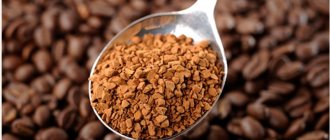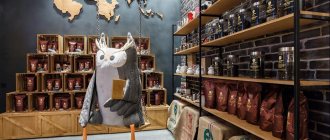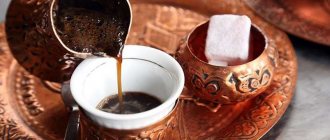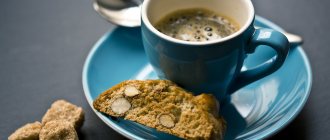It seems that brewing coffee in a Turk is not difficult: the device is simple, you just need to pour in ground coffee, add water and heat it. But some people cook it thin and weak, some cook it just right, while others cook it bitter, strong and sharp. Much depends on the coffee itself, as well as on personal preferences, but if you are just starting to master preparing a drink in this way, it is worth finding out how many spoons of coffee to put in a coffee pot for 1 person, as well as in a 300 or 500 ml pot, for any volume. With our calculations, you can brew an amazing drink in a cezve according to your taste.
gold standard
The so-called gold standard or golden ratio is the ratio of coffee grounds (grams) to water volume (ml) of 1:18. This definition comes from the Coffee Association of America (SCAA) and is generally considered the standard for coffee. This, of course, is a simple number and easy to remember, but no one will measure such proportions every time.
The best ratio is the one you like. Plus or minus a couple of grams usually doesn't change anything. If you try any instructions or recommendations online and you don’t like them, keep experimenting. Your coffee is solely your pleasure.
Important: try to take a Turkish coffee cup for the amount of coffee you usually drink. It’s better to cook two servings in a small one than cook one serving for yourself in a too large one.
How many grams in one milliliter: formulas to help
To make the problem clear - how many grams are in a milliliter - we need to turn to the concept of density of a substance. All substances in nature have different densities.
This value is denoted by the letter p. It is equal to the ratio of a unit of mass to a unit of volume:
Note: in everyday life we find mass using scales. But in physics, weight and mass are not the same thing.
Weight is the force with which an object presses on a support; it depends on the force of gravity. Mass is the amount of matter.
If the force of gravity changes (for example, on the Moon, in space - weightlessness), then the mass will remain the same, but the weight will change. Therefore, the mass per unit volume is not the same for different substances.
For example, to calculate the density of water, you need to divide 0.25 kg (the mass of water in a full glass) by the volume of water in a glass of 0.25 liters (or 250 g divided by 250 ml). It can be seen that the density of water is approximately equal to 1.
Why approximately? Because any measurements have inaccuracies (errors).
Conclusion: 1g of water fits into 1ml of volume. Accordingly, 100 grams of water is 100 milliliters. For all other substances this equality will not be fair.
For example, if you fill a glass with sugar, the volume will be 250 ml, but the mass (use scales) is no longer 250 g, but only 200 g. 1 glass of water, 1 glass of milk, 1 glass of sugar, 1 glass of sunflower oil - they will all be have different masses.
Conclusion: 1 g of any substance other than water occupies a volume not equal to 1 ml (the exception is substances with the same density as water).
Factors that influence the taste of Turkish coffee
Even if you calculate the ideal dosage of coffee for 1 or 2 people, 350 or 600 ml per Turk, the taste will only be necessary if you use the same coffee, the same cups, spoons and water. Changing any of these factors in some sense affects how many spoons of coffee to put in the Turk.
- Type of coffee. Robusta is traditionally more bitter and strong, full-bodied. Arabica is softer and more aromatic. Blends are packaged in different proportions; Arabica can be 90%, 80%, or even 60%. If you change your favorite brand, the taste will change a little.
- Features of grain. Depending on at what altitude and in what climate the coffee trees grew, how they were processed, the taste in the cup will change, sometimes it is quite clearly felt. Different manufacturers use different varieties of beans, hence the differences.
- Roasting degree. A light roast will reveal notes of flowers and citrus, a medium roast will reveal honey, vanilla and chocolate tones, and a strong roast will reveal a bright taste of dark chocolate and burnt caramel.
- Grinding degree. Turkish coffee usually requires a fine grind, almost to dust, this is how coffee is prepared in the Oriental style. If the grind is very coarse, the drink will brew faster, but its taste will be more watery and the flavors will not have time to develop. If you buy ground coffee in packs, the standard grind is medium, so you have to keep the drink on the fire longer to release the flavor components.
- Cooking speed. Some people like a long brewing process accompanied by pleasant conversations, so that the spices and coffee release all their oils and fill the kitchen with a mind-blowing aroma. Others are always in a hurry and prepare coffee almost on the run, on a strong window, just to make it faster.
For Turks, it is advisable to use the finest grind and cook over low heat, so you will get a pleasant velvety consistency.
Dependence of coffee weight on grinding
To be absolutely clear, it is necessary to take into account that the weight of the product will differ from the degree of grinding. The smaller the fraction, the more the spoon can hold and, accordingly, the more weight, and vice versa. The difference may be 1-2 grams.
An ordinary measuring spoon is included with coffee makers and coffee machines and its capacity is 7 grams, which is exactly what is required for one serving of coffee with a rich taste and aroma.
Drip coffee maker: Prepare real, faithful dark coffee.
“Catastrophically good coffee! Strong coffee..." - the words of Agent Cooper from Twin Peaks. This is the kind of coffee most of us need early in the day before going to work. A filter coffee maker solves this issue for us. The main thing is to maintain the proportions of coffee and water. ?
Invented in 1908 by German housewife Mellita Benz, this common method of making coffee has become popular throughout the world. A drip coffee maker, thanks to its own operating mechanism, does not affect the quality of the drink. With the right ratio of coffee and water, you can brew equally delicious coffee both in a coffee shop and in a regular coffee maker at home. Other names for this drink: Filter coffee, Regular and even, from time to time, Americano!
Fun fact: filter coffee vs Americano! It all started with American fighters and their love for black filter coffee.
The drink, which is prepared in an espresso machine, received the name “Americano” during the 2nd World War during the occupation of Italy by US troops. South American fighters, missing their homeland and missing black coffee, ordered an unusually strong Espresso from Italian cafes and diluted it with hot water to make the drink look like filter coffee. Then the Italian baristas christened it “Americano” (which means: South American), and wrote down the recipe: “dilute the divine Espresso with boiling water until it is unrecognizable.”
So how many spoons of coffee should you put in a Turk for one person?
There is not and cannot be a clear answer: some people like very strong espresso and drink it from a 50 ml cup, others brew 300 ml and like to drink it from a huge mug. However, calculation methods still exist:
Typically, a 200 ml serving uses 7 grams of ground coffee.
- A level teaspoon holds approximately 4 g of ground grain.
- A heaped teaspoon contains approximately 6 grams.
That is, if we need 7 g, that’s about 2 level spoons per cup or one heaped spoon and a little more at the tip.
It is advisable to use the scale at least once and measure exactly how much fits into the specific devices you use when measuring.
Now let’s measure the approximate amount of coffee per cup of different sizes:
| Easier if this is not the first cup of the day, g | Usual to wake up in the morning, g | Strong enough to dilute with milk, g | |
| 30 ml, espresso | 4 | 5 | 7 |
| 100 ml, those same “half a cup of coffee” | 4 | 5 | 6 |
| 200 ml, small cup | 4 | 7 | 9 |
| 350 ml - usually the tallest cup for tea | 6 | 8 | 10 |
It is clear that the numbers are a bit relative; rarely does anyone measure grams. But remember about a heaped spoon - 6 g.
Enjoy your coffee!
And remember that there is always room for experimentation - try different grains, change the grind size, try brewing coffee, put a few ice cubes or slices of frozen fruit in a test tube so that the hot drink immediately cools and becomes especially sweet.
How to measure how much coffee you need per cup of drink.
The taste of the prepared drink directly depends on how much coffee is in the cup. The amount of product added must strictly correspond to that indicated in the recipe. Otherwise, the desired result will not be achieved. That’s why it’s so important to follow the dose. Using a kitchen scale is awkward every time. Knowing how many grams of crushed grains are in a teaspoon and a tablespoon, no problems will appear during the manufacturing process. Without any hesitation, the result will be pleasantly amusing.
Making Turkish coffee for 2 people
It would seem that the calculations should simply be twice as large, but in fact, this is not how it works. You need to pour in a little less, since the drink takes longer to prepare, which means it will be stronger. Even while the water is just heating up, the flavoring and aromatic substances are already beginning to pass into the liquid medium. That is, a higher concentration is obtained, and if you do not want the drink to be too strong, you should sprinkle less.
If you do not drink coffee at the same time, and for some, the drink remains in the Turk so that it does not cool down, it continues to be saturated, and as a result it will turn out to be too strong and bitter. Do not let the drink come into contact with the grounds in the cezve for a long time; pour it into cups immediately.
Concepts of mass units
What is a gram? This is a unit of mass equal to a thousandth of a kilogram. In the chain of units for measuring body weight, it looks like this: 1 milligram → 1 gram → 1 kilogram → 1 centner → 1 ton.
Each subsequent unit of measurement in the metric system is 1000 times larger than the previous one.
What is a milliliter? This is a unit of volume, named after the manufacturer of glass containers named Liter.
1 milliliter (1 cube) → 1 liter → 1 cu.
Each subsequent unit of measurement is 1000 times larger. A cube with an edge of 1 cm is a model of 1 cm3 = 1 ml, 1 dm3 = 1 l, 1 m3 = 1 cube.
Volumes of liquids are measured in milliliters and liters. But in cooking, bulk and liquid products are often used, the volume of which is conveniently measured using containers for liquids. The term cube is used in medicine when dosing injections.
How many spoons of coffee to put in Turks of different sizes
You need to base your calculations on how strong the drink you want to get in the end. On average, approximately, this is the same heaped teaspoon and a little more to prepare one serving. But it will be easier if we do the calculation:
| Turk / spoons | For 1 or 2 people | For company, or to dilute with more milk or boiling water |
| 300 ml | 7 | 12 |
| 350 ml | 8 | 12 |
| 400 ml | 14 | 18 |
| 500 ml | 18 | 21 |
| 600 ml | 20 | 28 |
Please note that in the second case, when you are preparing for a company, the drink turns out to be quite concentrated, and it should either be drunk in very small portions, like espresso, or diluted with cream, milk, or just boiling water.
Conclusions:
- To prepare an average portion of 200 ml, you should put a heaped spoonful of coffee in the pot and a little more on the tip.
- If you are making espresso, use a small heaped spoon.
- Do you like to drink Americano from a large cup - two spoons without a slide.
- For a serving for two, you should put a little less than what you get when multiplying the serving by two, since the drink is prepared more and will be stronger.
- You can almost always use the “spoon and a little extra” calculation to get an average drink, and vary it according to your feelings next time.











